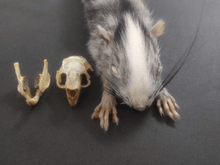Painted tree-rat
The painted tree-rat (Callistomys pictus) is a species of spiny rat from Brazil, restricted to north-eastern Bahia in eastern Brazil. It is the only species in the genus Callistomys.
| Painted tree-rat | |
|---|---|
 | |
| Scientific classification | |
| Kingdom: | Animalia |
| Phylum: | Chordata |
| Class: | Mammalia |
| Order: | Rodentia |
| Family: | Echimyidae |
| Subfamily: | Echimyinae |
| Tribe: | Myocastorini |
| Genus: | Callistomys Emmons and Vucetich, 1998 |
| Species: | C. pictus |
| Binomial name | |
| Callistomys pictus (Pictet, 1841) | |
| Synonyms | |
|
Isothrix picta Pictet, 1841 | |
Identification
With a total length of ca. 30 cm (12 in), it is a relatively large species of spiny rat. It is white with a strongly contrasting glossy-black cap, back and band down towards its forelimbs. Its long fur is dense and coarse, but not spiny, as in some other members of its family. Specimens often have brown (rather than black) markings, but as far as it is known this is caused by fading and does not occur in the living animals.
Owing to its striking black-and-white pelage, it is virtually unmistakable, but could perhaps be confused with a hairy dwarf porcupine (Coendou spp.) – all of which have spines and lack the distinctive pattern of the painted tree-rat.
Etymology
- The genus name Callistomys derives from the two ancient greek words κάλλιστος (kállistos) meaning "very beautiful", — i.e., this is the superlative form of καλός (kalós) meaning "beautiful, handsome" —, and μῦς (mûs), meaning "rat".[2][3]
- The species name derives from the Latin word pictus meaning colored, decorated,[4] and refers to the white and black fur of this rodent.
Habitat
The painted tree-rat is found in the Atlantic forest. It also occurs in cocoa plantations where some native trees remain. As far as known, it is nocturnal.
Phylogeny
The painted tree-rat has been placed in different genera: Nelomys, Loncheres, or Isothrix.[5] However, analyses of DNA and protein characters showed that the genus Callistomys is the sister group to the genus Myocastor (coypus or nutrias).[6][7] In turn, these two taxa share evolutionary affinities with other Myocastorini genera: Proechimys and Hoplomys (armored rats) on the one hand, and Thrichomys on the other hand.
| Genus-level cladogram of the Myocastorini. | ||||||||||||||||||||||||
| ||||||||||||||||||||||||
| The cladogram has been reconstructed from mitochondrial and nuclear DNA characters.[8][9][10][6][11][12][7] |
Conservation status
The painted tree-rat is currently listed as Endangered by the IUCN because of its fragmented distribution, its continuing decline and the quality of its habitat. An outlying record was not included in the assessment.[1]
See also
- Emmons, Louise H.; Feer, François (1997-09-02). Neotropical rainforest mammals. A field guide (2nd ed.). Chicago: University of Chicago Press. pp. 1–307. ISBN 978-0-226-20721-6. OCLC 44179508.
References
- Moura, R. & Faria, D. (2008). "Callistomys pictus". IUCN Red List of Threatened Species. 2008. Retrieved 5 January 2009.CS1 maint: ref=harv (link)
- Bailly, Anatole (1981-01-01). Abrégé du dictionnaire grec français. Paris: Hachette. ISBN 978-2010035289. OCLC 461974285.
- Bailly, Anatole. "Greek-french dictionary online". www.tabularium.be. Retrieved 2017-01-24.
- Gaffiot, Félix (1934). Dictionnaire illustré Latin-Français (in French). Paris: Librairie Hachette. p. 1179. Retrieved 7 October 2017.
- Patton, James L.; Pardiñas, Ulyses F. J.; D’Elía, Guillermo (2015-03-09). Mammals of South America, Volume 2: Rodents. University of Chicago Press. pp. 889–890. ISBN 9780226169606.
- Loss, Ana; Moura, Raquel T.; Leite, Yuri L. R. (2014). "Unexpected phylogenetic relationships of the painted tree rat Callistomys pictus (Rodentia: Echimyidae)" (PDF). Natureza on Line. 12: 132–136.
- Fabre, Pierre-Henri; Upham, Nathan S.; Emmons, Louise H.; Justy, Fabienne; Leite, Yuri L. R.; Loss, Ana Carolina; Orlando, Ludovic; Tilak, Marie-Ka; Patterson, Bruce D.; Douzery, Emmanuel J. P. (2017-03-01). "Mitogenomic Phylogeny, Diversification, and Biogeography of South American Spiny Rats". Molecular Biology and Evolution. 34 (3): 613–633. doi:10.1093/molbev/msw261. ISSN 0737-4038. PMID 28025278.
- Galewski, Thomas; Mauffrey, Jean-François; Leite, Yuri L. R.; Patton, James L.; Douzery, Emmanuel J. P. (2005). "Ecomorphological diversification among South American spiny rats (Rodentia; Echimyidae): a phylogenetic and chronological approach". Molecular Phylogenetics and Evolution. 34 (3): 601–615. doi:10.1016/j.ympev.2004.11.015. PMID 15683932.
- Upham, Nathan S.; Patterson, Bruce D. (2012). "Diversification and biogeography of the Neotropical caviomorph lineage Octodontoidea (Rodentia: Hystricognathi)". Molecular Phylogenetics and Evolution. 63 (2): 417–429. doi:10.1016/j.ympev.2012.01.020. PMID 22327013.
- Fabre, Pierre-Henri; Galewski, Thomas; Tilak, Marie-ka; Douzery, Emmanuel J. P. (2013-03-01). "Diversification of South American spiny rats (Echimyidae): a multigene phylogenetic approach". Zoologica Scripta. 42 (2): 117–134. doi:10.1111/j.1463-6409.2012.00572.x. ISSN 1463-6409.
- Fabre, Pierre-Henri; Vilstrup, Julia T.; Raghavan, Maanasa; Der Sarkissian, Clio; Willerslev, Eske; Douzery, Emmanuel J. P.; Orlando, Ludovic (2014-07-01). "Rodents of the Caribbean: origin and diversification of hutias unravelled by next-generation museomics". Biology Letters. 10 (7): 20140266. doi:10.1098/rsbl.2014.0266. ISSN 1744-9561. PMC 4126619. PMID 25115033.
- Upham, Nathan S.; Patterson, Bruce D. (2015). "Evolution of Caviomorph rodents: a complete phylogeny and timetree for living genera". In Vassallo, Aldo Ivan; Antenucci, Daniel (eds.). Biology of caviomorph rodents: diversity and evolution. Buenos Aires: SAREM Series A, Mammalogical Research — Sociedad Argentina para el Estudio de los Mamíferos. pp. 63–120.
